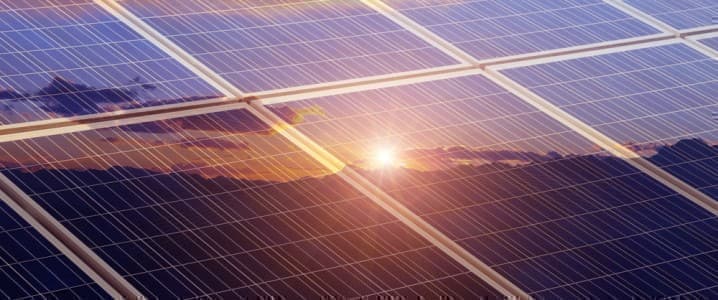The solar energy industry in the U.S. has grown rapidly over the last decade, second only to wind power. But supply chain issues, made worse by the tariffs on solar panels manufactured in Southeast Asia, have been pushing costs up for the U.S. solar industry. This month, President Biden announced the waiving of certain tariffs on solar imports, sending stocks soaring, and potentially giving the sector a game-changing boost.
U.S. solar energy production increased from 1.82 TWh in 2011 to a giant 163.7 TWh in 2021, with significantly more sectoral growth than any renewable source other than wind. Solar photovoltaic (PV) installed capacity is now enough to power around 22 million homes, with solar power accounting for 50 percent of all new electricity-generating capacity added in the first quarter of 2022.
However, much like in other parts of the world, the U.S. solar energy industry is suffering from ongoing delays in the supply chain, with the new installed capacity falling by 24 percent in Q1 2022 compared to the same period in 2021. In addition, 17.6 GW of utility-scale solar projects were delayed by a year or more, with 450 MW of developments being canceled altogether. Despite these challenges, the push for solar energy development in the face of global energy shortages means that the U.S. solar industry is expected to continue growing substantially over the next decade to provide around 15 percent of electricity generation by 2030. This month, President Biden announced a plan to waive tariffs on the import of solar panels manufactured in Southeast Asia for two years, to support the development of the American solar industry supply chain. The Department of Commerce (DoC) is currently carrying out an investigation to determine whether U.S. solar panel imports from Cambodia, Malaysia, Thailand, and Vietnam – using Chinese components – are circumventing an antidumping duty. The investigation could massively delay solar energy projects in the U.S. due to the fear of tariffs and retroactive tariffs of up to 250 percent being introduced. However, Biden’s pause on tariffs also applies to retroactive tariffs, allowing renewable energy firms to feel confident in their investments in solar.
The pause on tariffs made solar stocks soar earlier this week. On Monday, Sunrun shares increased by 5.9 percent, Enphase stock went up by 5.4 percent, SolarEdge Technology, and SunPower by almost 3 percent and Array Technologies rose by 18 percent. JPMorgan analyst Mark Strouse explained of the move, “We believe the announcement will be a clear positive for our coverage, particularly within the utility-scale solar market, which has faced uncertainty since the US Department of Commerce’s AD/CVD investigation was launched in late March.”
Tariffs on solar imports were first introduced under the Trump administration and were extended by four more years by President Biden earlier this year. However, due to global energy shortages and the push to transition to green more rapidly, they have gained a great deal of criticism. Further, domestic solar companies believe tariffs put the aim of significantly decarbonizing the U.S. economy by 2030 at risk.
Related: Why Nuclear Energy Is More Relevant Than Ever
The U.S. is highly dependent on imports for its solar energy operations, sourcing around 89 percent of its solar modules from overseas, the majority of which come from Southeast Asia. At present, China dominates the global solar manufacturing market. It has achieved this position by subsidizing production, allowing for highly competitive pricing. The U.S. introduced tariffs largely to counteract the low pricing of Chinese solar components, and to ensure imports do not undermine trade laws that protect American workers.
Commerce secretary said of the pause on tariffs, “The president’s emergency declaration ensures America’s families have access to reliable and clean electricity while also ensuring we have the ability to hold our trading partners accountable to their commitments.”
With or without tariffs, the U.S. solar outlook is strong. It is expected to significantly expand its solar manufacturing market in the coming years, tripling capacity by 2024. This would allow for around 3.3. million homes annually to switch to solar power. It is also expected to create job opportunities in domestic manufacturing and construction, as well as cut energy costs, strengthen the grid, and help tackle climate change, according to a statement from the White House.
The U.S. has already achieved record levels of renewable energy output this year, generating 20 percent of its electricity from wind and solar power in April. This marks an increase from just 5.7 percent in 2015. Wood Mackenzie predicts 14 percent year-over-year solar growth in 2022.
The U.S. has been rapidly growing its solar energy industry over the last decade. Despite the headwinds it has faced, solar remains the fastest-growing renewable sector in 2022. Biden’s lifting of tariffs on Southeast Asian solar panel imports is expected to encourage greater solar investment across the country and allow the U.S. the time it needs to develop a solar manufacturing sector to sustain its solar dominance well into the next decade.
ADVERTISEMENT
By Felicity Bradstock for Oilprice.com
More Top Reads From Oilprice.com:
- Oil Prices Rise As EU Leaders Agree On Partial Russian Crude Ban
- Could Iraq Dethrone Saudi Arabia As Largest Oil Producer?
- Citi: Oil Is Overvalued By $50 Per Barrel


















